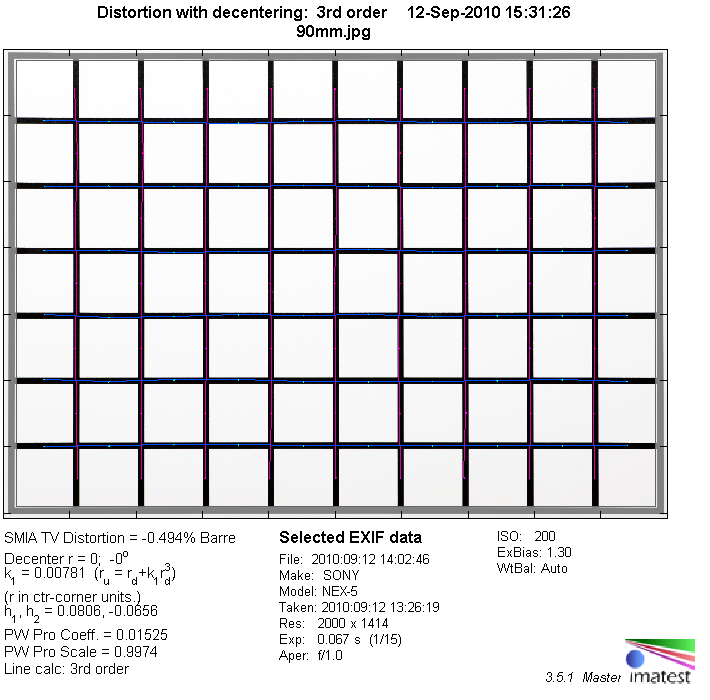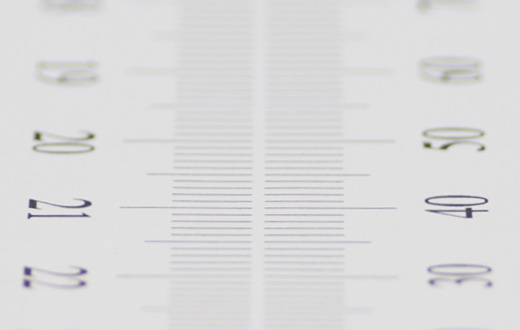|
Voigtlander APO-Lanthar 90mm f/3.5 (on Sony NEX) - Review / Test Report - Analysis |
|
Lens Reviews -
Sony Alpha/NEX (APS-C)
|
|
Page 2 of 2

Distortion
The APO-Lanthar produces a slight amount of barrel distortion (~0.5%) which is not overly field relevant.

Vignetting
Typical for most full format lens there're no problems with respect to light fall-off on APS-C cameras. The issue is just slightly noticeable at f/3.5 and negligible beyond.

MTF (resolution)
The Voigtlander lens delivers very decent and even resolution characteristics across the tested aperture range but it does not reach extreme performance levels here. The center and quality is very good from f/3.5 till f/8. Diffraction effects reduce the quality from f/11 onwards.
Please note that the MTF results are not directly comparable across the different systems!
Below is a simplified summary of the formal findings. The chart shows line widths per picture height (LW/PH) which can be taken as a measure for sharpness.
If you want to know more about the MTF50 figures you may check out the corresponding Imatest Explanations
Chromatic Aberrations (CAs)
Lateral CAs (color shadows at harsh contrast transitions) are exceptionally well controlled at less at 0.5px on the average pixel at the image borders. This is negligible from a field perspective. The APO design of the lens helped quite a bit here.

Bokeh
The quality of the bokeh (out-of-focus blur) is, of course, a primary aspect of a fast prime lens and the APO manages to provide very pleasing results here. Out-of-focus highlights show a slight outlining effect at f/3.5. The quality of the blur in the critical focus transition zones is very smooth both in the image foreground and background.

Bokeh Fringing / Longitudinal Chromatic Aberrations (LoCA)
LoCAs (non-coinciding focal planes of the various colors) are a common issue with relatively fast glass. As you can
notice below the halos have different colors - magenta (red + blue) in front the focus point and green beyond. The Lanthar is not perfectly corrected at f/3.5 but the problem is gone from f/5.6 onwards.
|
Move the mouse cursor over the f-stop marks below to observe the respective LoCAs
|
| f/3.5 |
f/5.6 |
|

|
VerdictThe Voigtläander APO-Lanthar 90mm f/3.5 is slightly superior to the Heliar 75mm f/2.5 that we've tested here recently. Its peak resolution may not be exceedingly high but it's still reaching a very good level across the image frame straight from f/3.5. Vignetting and distortions are very well controlled and not an issue from a real world perspective. The bokeh (out-of-focus blur) is pretty smooth and buttery (for such a comparatively slow speed lens). The APO element is probably responsible for the very high contrast level combined with low lateral CAs and relatively moderate bokeh fringing (LoCAs). However, we wouldn't really sign that the APO Lanthar is an apochromatic lens. Typical for Voigtländer lenses the build quality is on a very high level thanks to a tightly assembled metal body and smooth controls. The biggest weakness of the APO Lanthar is probably the relatively small max. aperture which imposes some limitations regarding the depth-of-field potential. However, it's still good enough for decent portraits and the slow speed allows a fairly compact design and, of course, a low price tag at roughly half the price of the comparable Zeiss ZM Tele Tessar 85mm f/4. At the time of this review there're no native Sony E-lenses in this range so the Voigtlander is surely a viable option if you can accept the limitations of an adapter solution.
|